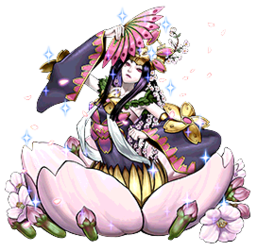Plant Princess
| Plant Princess | |||||||||||||
|---|---|---|---|---|---|---|---|---|---|---|---|---|---|
 | |||||||||||||
| Japanese |
| ||||||||||||
| |||||||||||||
| Lists | |||||||||||||
The Plant Princesses[1], officially called Botanical Princesses[2] (
The titles of the princesses are portmanteaus of the names of flowers and the words for princesses (including 姫) for spelling and pronunciation, and 王妃 for pronunciation only).
Members[edit]
| Plant Princess | Japanese title | Portmanteau | Goddess | Plant |
|---|---|---|---|---|
| Chirubimé, Princess of Autumn Leaves | 紅姫 (aki) | 秋 (aki, " autumn") + 姫 (ki, "lady") | Konohanachiruhime | Maple |
| Mariña, Princess of Sunflowers | 姫葵 (himari) | 姫 (hime, "lady") + 向日葵 (himawari, "sunflower") | Malina | Sunflower |
| Talaya, Princess of Cherry Blossoms | 桜姫 (ōhi) | 王妃 (ōhi, "princess consort") + 桜 (ō, "cherry blossom") | Thalia | Cherry blossom |
| Tytannial, Princess of Camellias | 椿姫 (tsubaki) | 椿 (tsubaki, "camellia") + 姫 (ki, "lady") | Titania | Camellia |
Playing style[edit]
Their strategy relies on protecting Plant monsters from being destroyed by battle or against card effects.
- "Talaya" protects other Plants against card effects that would destroy them.
- "Chirubimé" protects all other Plant monsters from attacks and can replace itself with another Princess if it is sent to the Graveyard by your opponent.
- "Tytannial" negates any effect that targets your monsters, by the cost of a Tribute.
- "Mariña" punishes your opponent for destroying one of your Plants.
As usual, "Lonefire Blossom" is the quickest way to bring the "Princesses" to the field. "Cherry Inmato" and "Rose Witch" can also be used as the required tributes for Tribute Summon while cards like "Lord Poison" and "Blue Rose Dragon" can Special Summon them from Graveyard. During your turn, "Miracle Fertilizer" can also Special Summon them from the Graveyard as well.
If the player wishes to Summon "Number 87: Queen of the Night", three princesses are required. One can also use the effect "Xyz Dimension Splash" to quickly Special Summon 2 "Talaya", Summon "Copy Plant" and use its effect to easily Xyz Summon this card.
Recommended cards[edit]
Weakness[edit]
While the "Princesses" are fairly powerful, they also possess some weaknesses:
- "Talaya" cannot protect itself and is susceptible of being destroyed if there is only one copy of it on the field.
- "Chirubimé" is vulnerable to cards that can remove it from the field without sending it to the Graveyard, such as "Bottomless Trap Hole", "Virgil, Rockstar of the Burning Abyss", "Dark Core" etc
- "Mariña" effect doesn't activate if multiple monsters are destroyed at once and requires itself to be on the field for the effect to resolve, which makes it vulnerable to "Book of Moon", "Compulsory Evacuation Device", etc, if those cards are chained to its effect activadion.
- "Tytannial" requires a Plant monster to be used as Tribute in order to negate a targeting effect, which also makes its effect useless if it is the only monster under its owner's control.
All of them are Level 8 and unless "Lonefire Blossom", "Gigaplant", "Rose Lover" are used to Special Summon them or if they are not used as cost for "Trade-In" they could easily be dead draws.
The variety of Attributes also makes them vulnerable to "Gozen Match".
Trivia[edit]
- The Japanese name of "Number 87: Queen of the Night", "Numbers 87: Beautiful Goddess of the Four Seasons - Queen of Nights" implies that, if it is included with the princesses, this family may be intended to symbolize the four seasons as follows.
- "Tytannial" represents Winter, as many Camellia species also bloom in mid to late winter, which is a season also known for strong winds.
- "Talaya" represents Spring, since it is WATER, and Spring is typically a rainy season. In addition, the flower it is based off, the Cherry Blossom, blooms in Spring– around April– when Cherry Blossom Festivals are typically held.
- "Mariña" represents Summer, given that it is FIRE, and Summer is universally the hottest season. In addition, Sunflowers are the only flower featured in the princesses' artwork that blooms in Summer.
- "Chirubimé" represents Autumn, as its name explicitly calls it "Princess of Autumn Leaves." Furthermore, it is EARTH, and Autumn is associated with the harvest season. In addition, the plant it is based upon is the Maple Tree, whose leaves undergo a vivid spectrum of color changes in autumn.
- In addition, the order in which the "Plant Princesses" were released in the core Booster Packs may be meant to parallel the cycle of seasons. ("Tytannial"/Winter in "Crossroads of Chaos", "Talaya"/Spring in "Judgment of the Light", "Mariña"/Summer in "Shadow Specters", and "Chirubimé"/Autumn in "Legacy of the Valiant")
References[edit]
- ↑ Kohamin, Michael. "The Trees Have Eyes". Konami.com.
- ↑ Monster Art Works